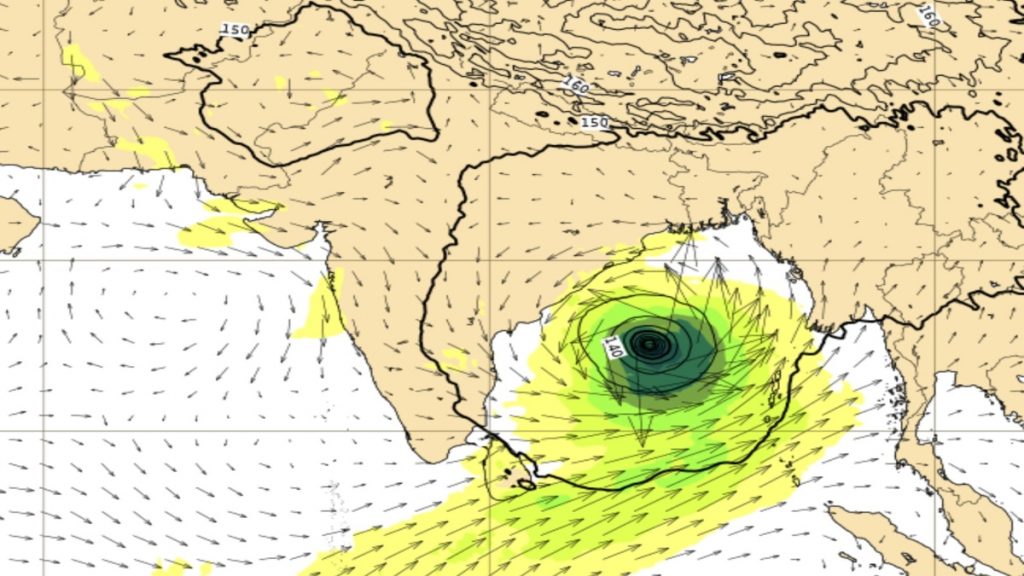


The India Meteorological Department (IMD) has reported possible developments in the weather patterns over the Bay of Bengal, including the formation of an upper air cyclonic circulation on November 5 and a potential low-pressure area by the end of the week. Several numerical models suggest the likelihood of a depression forming around November 7, adding complexity to the evolving weather situation. Environmental indicators also point towards favorable conditions for cyclonic activity in the region. Authorities in Tamil Nadu and other coastal states are advised to stay vigilant, given the recent impact of Cyclone Dana and the seasonal patterns in the area.
Cyclonic Activity in the Bay of Bengal: IMD Reports Potential Developments
Background
The Bay of Bengal is a marginal sea of the Indian Ocean, located between the Indian subcontinent to the west and Myanmar to the east. It is known for its frequent cyclonic activity, particularly during the monsoon season (June to September) and the post-monsoon period (October to December). Cyclones in the Bay of Bengal can cause significant damage and loss of life due to strong winds, heavy rainfall, and storm surges.
Recent Developments
The India Meteorological Department (IMD) has issued a report indicating possible developments in the weather patterns over the Bay of Bengal. According to the report:
Environmental indicators also suggest favorable conditions for cyclonic activity in the region. Authorities in Tamil Nadu and other coastal states have been advised to remain vigilant, especially considering the recent impact of Cyclone Dana.
Top 5 FAQs and Answers
1. What is a cyclone?
A cyclone is a large-scale, rotating storm system that forms over warm ocean waters. Cyclones are characterized by strong winds, heavy rainfall, and low atmospheric pressure at their center.
2. How do cyclones form?
Cyclones form when warm, moist air rises from the ocean surface and condenses to form clouds. As the clouds grow, they release heat energy, which fuels the storm system.
3. What is the difference between a cyclone, a depression, and a storm surge?
A depression is a low-pressure area with winds that are less than 63 kilometers per hour (39 miles per hour). When the winds in a depression reach or exceed 63 kilometers per hour, it is classified as a cyclone. A storm surge is a sudden rise in sea level caused by a cyclone.
4. What are the potential impacts of a cyclone?
Cyclones can cause a range of impacts, including:
5. What can be done to prepare for a cyclone?
There are several steps that can be taken to prepare for a cyclone, including:

In a recent family vlog, Indian celebrity couple Shoaib Ibrahim and Dipika Kakar shared their "natural" hair care routine for their son, using a homemade mask made with rice flour, flax seeds, and coconut oil. However, experts warn that what works for adults may not be suitable for babies, whose sensitive skin and scalp could react to the ingredients. While the ingredients may improve hair texture, they do not necessarily promote hair growth. Instead, a healthy diet and good scalp care are more important in maintaining healthy hair.

A recent consumer study has found multiple brands of soft contact lenses in the U.S. to contain "forever chemicals" that can be harmful to both the body and the environment. The study, conducted by the nonprofit organization Environmental Health Sciences, tested 18 varieties of popular contact lenses and found all of them to contain markers for PFAS. Brands such as Acuvue, Alcon, and CooperVision were among the list of affected products. This news serves as a cautionary lesson on the potential risks of overusing contact lenses.

On the birth anniversary of Dr. APJ Abdul Kalam, the ‘Missile Man’ of India, tributes pour in on social media celebrating his life, vision and impact. A visionary scientist, inspiring leader and true patriot, Dr. Kalam's humility, compassion and constant interaction with students continue to inspire generations. His tireless efforts in defense, science and youth empowerment have strengthened India's path towards self-reliance and his legacy continues to motivate young minds to dream big and work hard for the nation.

Recent studies have found that extreme heat, particularly when combined with high humidity, can have a significant impact on mental health. A study in India showed that when wet bulb temperature exceeded 27°C, the probability of reporting severe depression increased by 0.5%, even when the temperature was slightly lower. This finding is consistent with global reviews that have linked high temperatures to mood disorders, increased hospital admissions for psychiatric conditions, and even elevated suicide risk. The Lancet has also published evidence that rising temperatures worldwide are a growing threat to emotional and cognitive health.

In a meeting with university officials in Udaipur, Rajasthan Governor Hari Bhau Bagde stressed the importance of incorporating India's ancient knowledge traditions into academic research. He highlighted the deep repository of knowledge in India since ancient times and urged scholars and scientists to draw upon this tradition in their work. Bagde also suggested making ancient texts available in university libraries for study and research purposes, in order to shape the intellectual abilities and love for the nation among the younger generation.

John Clarke, Michel H. Devoret, and John M. Martinis have been awarded the 2025 Nobel Prize in Physics for their pioneering research into quantum mechanical tunnelling. Their discovery has opened new possibilities for quantum technologies, and will be formally presented on December 10, the anniversary of Alfred Nobel's death. This announcement follows the tradition of recognizing transformative contributions to science, and the award carries a prestigious prize of 11 million Swedish kronor.

The US-Japanese trio of Mary E Brunkow, Fred Ramsdell, and Shimon Sakaguchi have won the 2025 Nobel Prize in physiology or medicine “for their discoveries concerning peripheral immune tolerance". Through their research, they have shown how the immune system is kept in check and why serious autoimmune diseases do not affect everyone. Sakaguchi found a new class of T cells, while Brunkow and Ramsdell discovered the explanation behind a specific mouse strain's vulnerability to autoimmune diseases. Together, they have significantly advanced our understanding of immunology and autoimmune diseases.

Indian astronaut Shubhanshu Shukla, who recently completed a 20-day space mission, shared his insights and experiences at the convocation ceremony of Dr. APJ Abdul Kalam Technical University. He highlighted the importance of patience, focus, and the inevitability of change in achieving success, and urged the graduating class to actively contribute to shaping a fearless and ambitious India.

The Regional Meteorological Centre (RMC) in Chennai has issued a weather alert for parts of Tamil Nadu, with thunderstorms and light to moderate rainfall expected on Saturday. The alert was issued due to the strengthening of a cyclonic circulation in the Bay of Bengal, which is likely to intensify and form a low-pressure area. The system is expected to affect Tamil Nadu, Puducherry, and Karaikal, with some areas experiencing heavy rainfall and gusty winds. The public is advised to stay updated and take precautions, especially in hilly and western districts.

As a step towards advancing India's deep-sea research capabilities, the Union Science Minister announced a landmark contract with the International Seabed Authority to conduct mineral exploration in the Indian Ocean for the next 15 years. This move will not only help India in expanding its scientific knowledge about the deep sea but also has the potential to strengthen its position as a leading player in the international seabed mining industry.